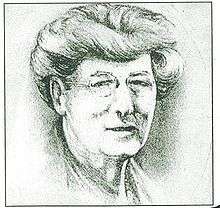E. M. Hull
| Edith Maud Hull | |
|---|---|
|
An anonymous sketch | |
| Born |
Edith Maud Henderson 16 August 1880 London, England, UK |
| Died |
11 February 1947 (aged 66) Hazlewood, Derbyshire, England, UK |
| Pen name | E. M. Hull, Edith M. Hull, Edith Maud Winstanley |
| Occupation | Novelist |
| Language | English |
| Nationality | British |
| Period | 1919-1939 |
| Genre | Romance fiction |
| Notable works | The Sheik |
| Spouse | Percy Winstanley Hull |
| Children | Cecil Winstanley Hull |
E. M. Hull (sometimes expanded as Edith M. Hull), was the pseudonym of Edith Maud Hull, née Henderson (16 August 1880 – 11 February 1947), a British writer of romance novels.[1][2] She is best known for The Sheik, which became an international best seller in 1921. The Sheik is credited with setting off a major and hugely popular revival of the "desert romance" genre of romantic fiction.[1][3] Hull followed The Sheik with several other novels with desert settings, such as The Shadow of the East, The Desert Healer, and The Sons of the Sheik.
Personal life
Born Edith Maud Henderson on 16 August 1880 in the Borough of Hampstead, London, England, UK, she was the daughter of Katie Thorne, of New Brunswick, Canada and James Henderson, a Liverpool shipowner originally from New York City.[1] As a child she travelled widely with her parents, even visiting Algeria—the setting of her novels.
In 1899, she married Percy Winstanley Hull (b. 1869), a civil engineer and later a prize-winning pig farmer.[1][4] The couple moved to the Hull family estate in Derbyshire in the early 1900s. They had a daughter, Cecil Winstanley Hull.
Hull was somewhat reclusive and did not seek the spotlight.[4] She died at age 66, on 11 February 1947 in Hazelwood, in the parish of Duffield, Derbyshire.[1]
Writing career
Hull wrote fiction while her husband was away serving in World War I.[1] The Sheik, her first effort, was published in England in 1919 and to her surprise quickly became an international blockbuster, placing among Publishers Weekly's top ten best sellers in America for both of the years 1921 and 1922.[5] Hull's volume quickly sold over 1.2 million copies worldwide. Sales further increased when Paramount released a film version of The Sheik in 1921, which launched Rudolph Valentino into cinema immortality as the greatest "lover" of the silent screen. By 1923, the novel had gone through over a hundred editions, and sales had surpassed all other bestsellers combined.[6] Hull's novel was not the first desert romance—the genre had been pioneered by writers like Robert Smythe Hichens and Kathlyn Rhodes—but it was by far the most popular and influential on later romance writers.[3]
Hull continue to write into the 1930s, and her 1925 novel The Sons of the Sheik was also a tremendous success, as was the film version Son of the Sheik, which again starred Valentino.
In later life, Hull expressed regret that she had sold the film rights for her novels for too little money.[4]
Bibliography
The Sheik saga
- The Sheik, 1919
- The Sons of the Sheik, 1925
Single novels
- The Shadow of the East, 1921
- The Desert Healer, 1923
- The Lion-Tamer, 1928
- The Captive of the Sahara, 1931
- The Forest of Terrible Things, 1939 (title in US: Jungle Captive)
Travel memoir
- Camping in the Sahara, 1926 (with photographs by Hull's daughter Cecil)[2]
See also
References and sources
- 1 2 3 4 5 6 "Hull, Edith Maud (1880-1947)". AIM25 website.
- 1 2 "Papers of Edith Maud Hull". The National Archives. (U.K. website)
- 1 2 Teo, Hsu-Ming. “Historicizing The Sheik: Comparisons of the British Novel and the American Film”. Journal of Popular Romance Studies.
- 1 2 3 Sergeant, Amy. "E M Hull Homepage". Women in Silent British Cinema website.
- ↑ Teo, Hsu-Ming. Desert Passions: Orientalism and Romance Novels
- ↑ Melman, Billie. Women and the Popular Imagination in the Twenties: Flappers and Nymphs. (New York: St. Martin’s Press, 1988).
Source: Mao, Douglas and Rebecca L. Walkowitz, eds. Bad Modernisms. Durham: Duke University Press 2006.
External links
- E. M. Hull Remembered
- Works by E. M. Hull at Project Gutenberg
- Works by or about E. M. Hull at Internet Archive
- Works by E. M. Hull at LibriVox (public domain audiobooks)

- The Sheik and The Shadow of the East Part of the PublicBookshelf online romance novel collection
- The Women's Library Archives, which contains "Books and papers relating to EM Hull"
